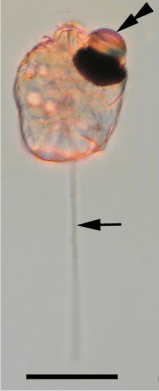Piston (subcellular structure)

An isolate of Erythropsidinium. The arrow indicates the piston; the double arrowhead indicates the ocelloid. Scale bar 20 µm.[1]
A piston (also known as a dart, prod, or tentacle) is a complex contractile organelle found in some dinoflagellates, namely the Erythropsidinium and Greuetodinium genera of the family Warnowiaceae. This group is also well known for possessing other unusually complex subcellular structures such as the ocelloid and nematocyst. Observations of Erythropsidinium samples reveal that the length of the piston is highly variable across specimens. The piston is known to be capable of repetitive and dramatic contractile motion; although its function is unknown, roles in locomotion, prey capture, and defense have been suggested.[1][2]
References
- 1 2 Hoppenrath, M; Bachvaroff, TR; Handy, SM; Delwiche, CF; Leander, BS (25 May 2009). "Molecular phylogeny of ocelloid-bearing dinoflagellates (Warnowiaceae) as inferred from SSU and LSU rDNA sequences.". BMC Evolutionary Biology. 9: 116. doi:10.1186/1471-2148-9-116. PMID 19467154.
- ↑ Gómez, Fernando (November 2008). "Erythropsidinium (Gymnodiniales, Dinophyceae) in the Pacific Ocean, a unique dinoflagellate with an ocelloid and a piston". European Journal of Protistology. 44 (4): 291–298. doi:10.1016/j.ejop.2008.03.002.
This article is issued from Wikipedia - version of the 1/29/2016. The text is available under the Creative Commons Attribution/Share Alike but additional terms may apply for the media files.